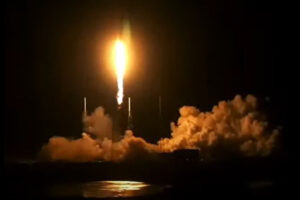NASA Launches High-Resolution Instrument To Monitor Major Air Pollutants

A NASA instrument to provide unprecedented resolution of monitoring major air pollutants – down to four square miles – lifted off on its way to geostationary orbit from Cape Canaveral Space Force Station in Florida atop a SpaceX Falcon 9 rocket.
The Tropospheric Emissions: Monitoring of Pollution (TEMPO) instrument will improve life on Earth by revolutionizing the way scientists observe air quality from space.
The instrument is a payload on the satellite Intelsat 40E, which separated from the rocket approximately 32 minutes after launch. It acquired signals within minutes. TEMPO commissioning activities will begin in late May or early June, NASA said.
“The TEMPO mission is about more than just studying pollution – it’s about improving life on Earth for all. By monitoring the effects of everything from rush-hour traffic to pollution from forest fires and volcanoes, NASA data will help improve air quality across North America and protect our planet,” said NASA Administrator Bill Nelson.
From a fixed geostationary orbit above the equator, TEMPO will be the first space-based instrument to measure air quality over North America hourly during the daytime and at spatial regions of several square miles – far better than existing limits of about 100 square miles in the U.S.
TEMPO data will play an important role in the scientific analysis of pollution, including studies of rush hour pollution, the potential for improved air quality alerts, the effects of lightning on ozone, the movement of pollution from forest fires and volcanoes, and even the effects of fertilizer application.
TEMPO’s observations will dramatically improve the scientific data record on air pollution – including ozone, nitrogen oxide, sulfur dioxide and formaldehyde – not only over the continental United States, but also Canada, Mexico, Cuba, the Bahamas, and part of the island of Hispaniola.
From its geostationary orbit – a high Earth orbit that allows satellites to match Earth’s rotation – TEMPO also will form part of an air quality satellite virtual constellation that will track pollution around the Northern Hemisphere.
South Korea’s Geostationary Environment Monitoring Spectrometer, the first instrument in the constellation, launched into space in 2020 on the Korean Aerospace Research Institute GEO-KOMPSAT-2B satellite, and is measuring pollution over Asia. The ESA (European Space Agency) Sentinel-4 satellite, scheduled to launch in 2024, will make measurements over Europe and North Africa.
“This marks a new era in our ability to observe air pollution over North America, including the entire continental United States,” said Barry Lefer, TEMPO program scientist and tropospheric composition program manager for NASA. “It’s also opening the door for us to work more closely with our international partners to better understand global air quality and its transport,” he added.
The instrument was built by Ball Aerospace and integrated onto Intelsat 40E by Maxar.
Source: Read Full Article
